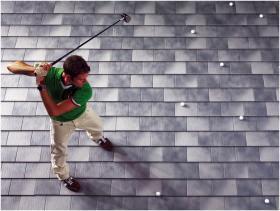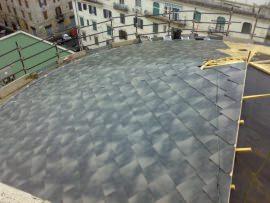Ceramic roofing slate
Post from EditorialsIn the field of coatings are becoming more way the new technologies, the slate tiles ceramics are one of these here is some more news.
Material selection in coverage
When building or restructuring a house, one of the aspects that commits us most is the one related to the choice of materials to use. So how do you choose the type of frame, floor or coating, in the same way in coverage trying to figure out what material may be the most convenient, functional and aesthetically pleasing. The ceramics slate tiles seem to solve this problem, as well as being beautiful and durable fit to any surface, whether flat or inclined.
What is the ceramic slate?
The ceramic slate is produced industrially, that can reproduce exactly the natural material by eliminating the defects caused by natural events. Its composition is very similar to that of a granite rock, then we are talking of a complex structure that is generated by slow cooling of the rock, as it happens for some volcanic rocks.
The ceramic slate in fact is a kaolin clay fused through a cooking process in furnaces at high temperature exceeding the 1200°C.
Being of industrial origin is a ceramic stone obtained from a mixture of different raw materials. The compound presents an essentially glass matrix, inside of which, there are more crystalline phases. The main constituents are plastic clays taking a binder function, little plastic clays, that instead given their composition cause alumina, silica and fluxes that are elements capable of containing the shrinkage and any deformation, which might occur during the hardening.
The main constituents are plastic clays taking a binder function, little plastic clays, that instead given their composition cause alumina, silica and fluxes that are elements capable of containing the shrinkage and any deformation, which might occur during the hardening.
Uses of ceramic slate
The working process which leads us to get the ceramic slate tiles is very similar to the technology of processing of porcelain stoneware, a very widespread material today for the construction of floorings. This material reproduce with great simplicity the natural stone, not only from the aesthetic point of view, but also in terms of performance. In fact we find it very used especially for covering surfaces, whether they are of the flat type and of great extent, whether they are instead inclined.
In fact we find it very used especially for covering surfaces, whether they are of the flat type and of great extent, whether they are instead inclined.
The elements in ceramics slate are used especially for exterior surfaces, especially for their high levels of impermeability, strength and impregnability by external agents. Furthermore they confer to the cover an effect that reproduces precisely that of natural stone, bringing with respect to it of the advantages in terms of performance, quality and economy.
The ceramic slate is also used for coatings of facades.
The formats available are varied such as 25x40 and 40x40, made by the company Ardogres
Features of ceramic slate
The ceramic slate tiles are resistant to wind and cold. That is why they are preferred as coating coverage. They are also highly resistant to abrasion, corrosion, stains, bending the light, frost, thermal shock and tensile strengths. A very important aspect that we must consider is the speed and cost of installation, as well as its technical characteristics more properly, in fact the ceramic slate are absolutely resistant to frost, it can also be used in cold climates and at high altitudes, it is unalterable, and it resists to atmospheric agents, acids, molds, fungi, etc.
A very important aspect that we must consider is the speed and cost of installation, as well as its technical characteristics more properly, in fact the ceramic slate are absolutely resistant to frost, it can also be used in cold climates and at high altitudes, it is unalterable, and it resists to atmospheric agents, acids, molds, fungi, etc.
The elements in ceramics slate by virtue of their fixing system, are very stable.
Furthermore, the structure of the lower face of the roof tile allows a micro-ventilation in the area of the attic which eliminates the phenomenon of capillarity.
Another company that produces this kind of slate tiles ceramics is ERC ASFALTI
The ceramic slate is a very light material, its colors are durable over time, because the individual tiles, made of colored mixtures, are cooked in ovens at very high temperatures. Furthermore, the slate tiles are not toxic as ceramic mainly made with clay, to which are added the oxides to obtain different colors.
Laying of ceramic slates
As it happens for laying all covering elements even in this case, the layer of tiles intervenes after the structure of the roof was completed, after which it was also verified the slope.
Predispose the strips of support, generally in wood at a distance of about 60 cm, then we proceed with the installation. Where it should be necessary to dissect the elements because the size of some of them are exaggerated you can proceed using a cutter from tiles.
The ceramic slate tiles may be laid on battens through two different anchoring systems, screwing or hooking, on the basis of inclination of the roof and to the aesthetic appearance to be obtained. It is important to know that each tile has two slotted holes and can then be screwed on the rails and, if it was needed, replaced quickly.
As regards the direction of laying, the ceramic slate tiles can be laid horizontal rows, from the eaves to the ridge line.
79735 REGISTERED USERS










